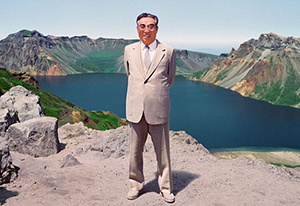 The Korean People’s Army, the regular armed force of the DPRK, was founded on February 8, 1948.
The Korean People’s Army, the regular armed force of the DPRK, was founded on February 8, 1948.
The founding of the Korean People’s Army provided the country with military guarantee for following the road of independent development.
The Korean People’s Revolutionary Army, the KPA’s predecessor, was founded on April 25, 1932 by Kim Il Sung, eternal President of the DPRK, when Korea was under the Japanese military occupation (1905-1945). Under his command, the KPRA, though it enjoyed no backing of a state and support of a regular army, waged a bloody guerrilla warfare against the one-million-strong Kwantung Army of Japan, which had been claiming to be the leader of Asia, and liberated the country on August 15, 1945.
After liberation, Kim Il Sung stepped up building a regular armed force by the efforts of the country itself on the basis of the rich experiences in army building created in the flames of the anti-Japanese armed struggle.
 Building a regular army of the nation was essential at that time for the establishment of a fully independent and sovereign state after liberation; it also emerged as an urgent task in view of the fact that the US stationed its aggressor troops in the southern half in an attempt to occupy the whole territory of Korea.
Building a regular army of the nation was essential at that time for the establishment of a fully independent and sovereign state after liberation; it also emerged as an urgent task in view of the fact that the US stationed its aggressor troops in the southern half in an attempt to occupy the whole territory of Korea.
As the personnel who could command a regular army were in short supply, Kim Il Sung enlisted most of the anti-Japanese war veterans in building the army, and saw to it that they not only became the backbone of the army to be built but played a pivotal role in training military cadres.
In order to train the military and political cadres indispensable in the establishment of regular armed forces, he ensured that regular military educational institutes were built and expanded.
As a result, the Pyongyang Institute was established as the first regular institute of military education and the first base for training political and military officers for the building of a modern regular army. Later its function of training military cadres was transferred to the Central Security Officers School set up to train military cadres of different arms and corps.
He gave field guidance at this school on several occasions, giving instructions on conducting military education not in any other’s way but in the Korean way.
At that time opinions varied at the school concerning the contents of military education, some people saying this country’s were good and others saying that country’s were good.
Defining these contents at this school was the core in training cadres for the regular armed forces to be organized later.
But some people were trying to mechanically adopt others’.
Kim Il Sung said to them: You must never copy others’ mechanically, but educate the cadets in line with the actual conditions in our country based on your own opinions. We are going to found a new type of regular army, so education must be conducted in our own way.
At another time after inquiring about the state of school education, he said to teachers of the KPRA origin that they should impart military techniques in our own way and play the role of backbone in school education, and that only when the cadets were given proper education can they train our army in our own way after their graduation.
And saying that the cadres who would form the backbone of the regular army should be trained by ourselves and that this was the only way of training the core personnel faithful to the Korean revolution and founding a genuine army of the new Korea, he paid close attention to organizing the navy and air force.
After its founding, the Korean People’s Army defended the country’s sovereignty and dignity with honour against the aggression of the allied imperialist forces in the early 1950s, and since then it has demonstrated to the whole world its might while foiling the military threats and provocations by the hostile forces at every step and defending peace on the Korean peninsula creditably.
Kim Il Sung’s achievements will shine for ever along with the founding of the regular armed force of the DPRK.


